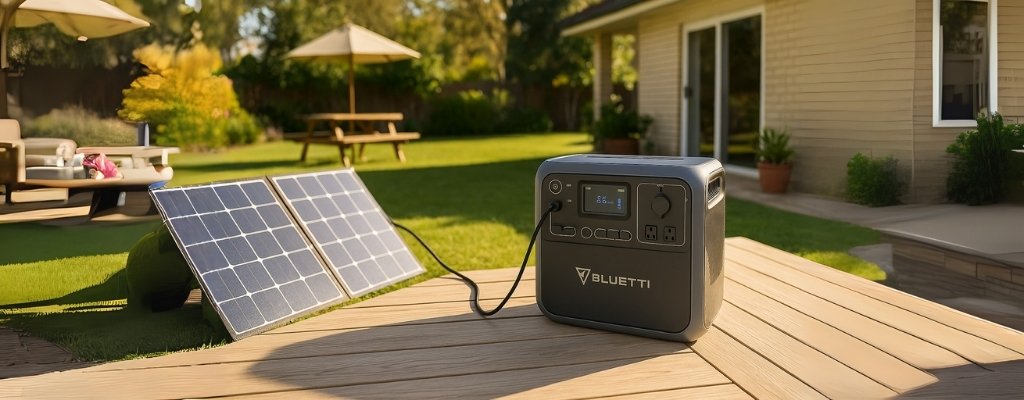
Does Bluetti Need a Solar Controller?
Wondering whether you need to fork out for a separate solar controller with your Bluetti? Good news: in most cases, you don’t. Let’s break down what’s going on under the hood—and when you might still need that extra bit of kit.
Not sure which power station is right for you?
Take the quiz!
What is a Portable Power Station Solar Charge Controller?
Regulating power from solar panels to batteries
A solar charge controller is a device that manages the energy flow between your solar panels and battery. It ensures power from the sun is delivered in the safest and most efficient way possible—without frying your battery.
Preventing overcharging and optimising charging
Think of it like a smart tap. Too much power, and your system could overheat. Too little, and you’re wasting sunlight. The controller balances things perfectly for optimal performance and battery life.
Types: PWM vs MPPT
There are two main types of solar charge controllers: PWM (Pulse Width Modulation) and MPPT (Maximum Power Point Tracking). PWM is basic, cheap and works well for small setups. MPPT, on the other hand, is far more efficient—especially in cloudy or inconsistent sunlight. That’s what Bluetti uses.

How Bluetti Portable Power Stations Manage Solar Input
Built-in MPPT charge controllers in all units
Does Bluetti need a solar controller? No. That’s because every modern Bluetti portable power station comes with an MPPT solar charge controller already integrated. These onboard units are specifically designed to draw the most power from your panels without needing an external controller.
Why no external solar controller is typically needed
The built-in MPPT setup ensures clean, regulated power goes straight into the battery. So when people ask, "Does Bluetti need a solar controller for solar panels?"—the answer in Australia and elsewhere is, not unless your panel setup exceeds the specs (more on that shortly).

Key Solar Specs for Your Portable Power Station
Voltage range (Voc - open circuit voltage)
Each Bluetti model has a voltage input range. Your solar panels’ open circuit voltage (Voc) must fall within this. Go too high, and you risk damaging the internal controller. Too low, and charging won’t initiate.
Current limit (Isc - short circuit current)
Your panel’s short circuit current (Isc) should also stay within Bluetti’s maximum input range. If it pushes past that, your unit could shut down or overheat.
Maximum wattage input
Wattage isn’t just about speed—it’s about safety. Each Bluetti model (e.g., EB3A, AC200P, AC300) has a max wattage rating. Stick within that to ensure efficient, trouble-free charging.
Connecting Solar Panels Directly to Your Bluetti Portable Power Station
Using correct connectors (MC4, Anderson, etc.)
Bluetti power stations support various input ports—most often XT60, XT90, Anderson, or aviation connectors. Many solar panels come with MC4 connectors, so an adapter is often needed. It’s an easy fix and usually included with your Bluetti kit.
Ensuring panel specs match Bluetti’s input requirements
Before plugging anything in, double-check your panel’s specs against your Bluetti’s manual. This is where many go wrong. Don’t mix a high-voltage commercial panel with a compact unit like the EB3A. Use compatible panels to avoid issues—and maximise output.

When Might You Encounter an External Controller? (Rare with Bluetti)
Very large, complex off-grid systems (Usually beyond typical portable power station use)
If you're setting up a large-scale, off-grid cabin system or daisy-chaining a dozen high-output panels, Bluetti’s internal controller may not cut it. In those rare cases, adding an external MPPT controller could help regulate the excess voltage and current safely.
Conclusion: Bluetti Simplifies Solar with Built-In MPPT Controllers
If you've been asking, “Does Bluetti need a solar controller in Australia?”—the answer is no for most users. Bluetti’s built-in MPPT solar charge controller handles it all. You get safe, efficient energy from the sun straight into your power station—no extras needed.
Just match your panel specs properly, use the right cable, and let Bluetti’s tech do the rest. Whether you’re topping up on a cloudy hike or running a solar-fed off-grid setup, your Bluetti’s ready for the task.


